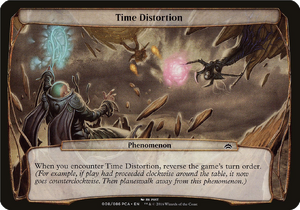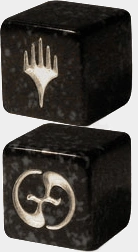Planechase 2012
| Planechase 2012 | |||||
|---|---|---|---|---|---|
| Set Information | |||||
| Set symbol | |||||
| Symbol description | Planes | ||||
| Design |
Mark Globus (lead), Kelly Digges, Dave Guskin, Ryan Miller | ||||
| Development |
Mark L. Gottlieb (lead), Ryan Miller, Lee Sharpe, Ken Troop, with contributions from Matt Tabak | ||||
| Art direction | Jeremy Jarvis | ||||
| Release date | June 1, 2012 | ||||
| Plane | Alara, Azgol, Belenon, Dominaria, Equilor, Ergamon, Fabacin, Innistrad, Kamigawa, Kephalai, Kolbahan, Kyneth, Lorwyn, Mirrodin, Mongseng, New Phyrexia, Ravnica, Regatha, Shandalar, Vryn, Zendikar | ||||
| Themes and mechanics | Plane cards, Phenomenons | ||||
| Keywords/ability words | Cascade, Devour, Ninjutsu, Umbra armor | ||||
| Set size |
156 cards +40 plane cards (four 60+10-card theme decks) | ||||
| Expansion code | PC2[1] | ||||
| Languages | English, French, German, Italian, Japanese, Spanish | ||||
| Planechase series | |||||
| |||||
| Magic: The Gathering Chronology | |||||
| |||||
| Scryfall Statistics | |||||
|
136 cards | |||||
Planechase 2012, officially styled as Planechase (2012 Edition), is a set of four "game packs", each consisting of ten oversized plane cards, a 60-card deck, a six-sided planar die and a strategy insert with multiplayer rules.[2][3] It was released in June, 2012.
Details
Planechase 2012 is built on the same Planar Magic variant format as its predecessor Planechase.[4] Each player has, in addition to their deck, an additional randomized deck consisting of at least ten oversized plane cards, their Planar deck. At any given moment, one of the plane cards of one players' Planar decks is face-up and its effect is active.
Any player can roll the planar die during their turn at any time they could cast a sorcery, and re-roll as many times as they want with each roll costing more than the previous one. If the die shows the planeswalker symbol (
), the current active plane is put on the bottom of its owners deck, and the player who rolled the die reveals the top card of their deck as the new plane. If the chaos symbol (
) is rolled, a specific effect on the currently revealed plane is triggered.

Planechase 2012 introduced a new card type, Phenomenon. Phenomena are similar to plane cards and are also put into the Planar deck, but represent one-time effects. When a Phenomenon is revealed, its effect is triggered, and then the player planeswalks to the next plane.[5]
Planechase 2012 introduced new, eternal format legal cards to the game. There were a total of 21 new cards between the four decks. Each deck had six new cards, with one card appearing in every deck. Three cards reprinted in the set featured new artwork. They are Armored Griffin, Concentrate, and Dark Hatchling.
When Planechase 2012 came out, there were release events. These features a special promo card that was not included in any of the four decks: Stairs to Infinity.[6]
Theme decks
Each of the four theme decks revisits a keyword.[7][8]
- Chaos Reigns features Cascade. As such, it embraces randomness and chaos, burying its opponents under the weight of multiple spells and creature-entry effects in a turn.
- Night of the Ninja features Ninjutsu. To support that theme, it contains small evasive creatures that can get through your opponents' defenses and get upgraded to Ninja-hood. It also has some card-drawing and control elements.
- Primordial Hunger features Devour. The deck is filled with creatures that love to die, often giving you replacement creatures in the process. Tokens abound.
- Savage Auras features Umbra armor (formerly Totem armor). Enchantments and enchantment-supporting spells are en masse, alongside creatures that thrive under the effects of Auras.
| Theme deck name |
Colors Included | ||||
|---|---|---|---|---|---|
| Chaos Reigns | W | U | B | R | G |
| Night of the Ninja | – | U | B | – | – |
| Primordial Hunger | – | – | – | R | G |
| Savage Auras | W | – | – | – | G |
Cycles

Planechase 2012 has one cycle consisting of one card per deck.
- Legendary creatures: Each deck has a multicolored legendary creature which works with its central theme listed above — Krond the Dawn-Clad, Maelstrom Wanderer, Thromok the Insatiable, and Vela the Night-Clad.
Pairs
- Multicolored cascade creatures: Multicolored blue creatures with cascade found in the Chaos Reigns deck. One is small and cheap, the other is more expensive and can repeat its cascade ability — Shardless Agent (Planechase 2012) and Etherium-Horn Sorcerer (Planechase 2012).
Notable cards
- Baleful Strix is a tournament viable creature in Legacy thanks to its several abilities for a low mana cost: it is evasive, it can be used like a removal thanks to deathtouch and it makes draw a card.
References
- ↑ Planechase 2012 Edition product information page — Wizards of the Coast
- ↑ Monty Ashley (Nov 23, 2011). "Announcing Planechase (2012 Edition)". magicthegathering.com. Wizards of the Coast. Archived from the original on 2018-05-25.
- ↑ Mark Rosewater (May 21, 2012). "Changing Planes". magicthegathering.com. Wizards of the Coast. Archived from the original on 2021-04-29.
- ↑ Mark Gottlieb (May 21, 2012). "Inside Planechase". magicthegathering.com. Wizards of the Coast. Archived from the original on 2021-04-29.
- ↑ Zac Hill (May 25, 2012). "Rolling Planes". magicthegathering.com. Wizards of the Coast. Archived from the original on 2021-04-29.
- ↑ Monty Ashley (May 22, 2012). "Planechase (2012 Edition) Release Promo". magicthegathering.com. Wizards of the Coast. Archived from the original on 2020-09-23.
- ↑ Monty Ashley (May 23, 2012). "Planechase (2012 Edition) Decks". magicthegathering.com. Wizards of the Coast. Archived from the original on 2021-04-29.
- ↑ Monty Ashley (May 28, 2012). "Planechase (2012 Edition) Decklists". magicthegathering.com. Wizards of the Coast. Archived from the original on 2018-12-01.
